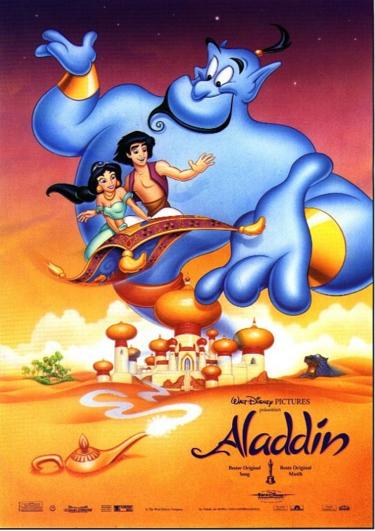 In Part 1 of our re-watch of Disney's Aladdin (the proper one, from 1992, not the live-action thing coming out this weekend) Ben got us through the introductions to good-hearted "street rat" Aladdin, frustrated princess Jasmine, and up to the mouth of the Cave of Wonders. We enter as Aladdin takes his first step into a whole new world…
In Part 1 of our re-watch of Disney's Aladdin (the proper one, from 1992, not the live-action thing coming out this weekend) Ben got us through the introductions to good-hearted "street rat" Aladdin, frustrated princess Jasmine, and up to the mouth of the Cave of Wonders. We enter as Aladdin takes his first step into a whole new world…
Part 2 by Tim Brayton
0:28:04 – Let's take just a minute to appreciate the atmospheric concision of this descent into the cave. First, we had a shot of Aladdin stepping over the tiger-god's teeth, dissolving into this beautiful wide shot of him (below) at the top of an impossible flight of stairs, a tiny bright dot in the overall gloom that shifts from cold blue to hot, threatening red as our eye glides down the lines of the composition.
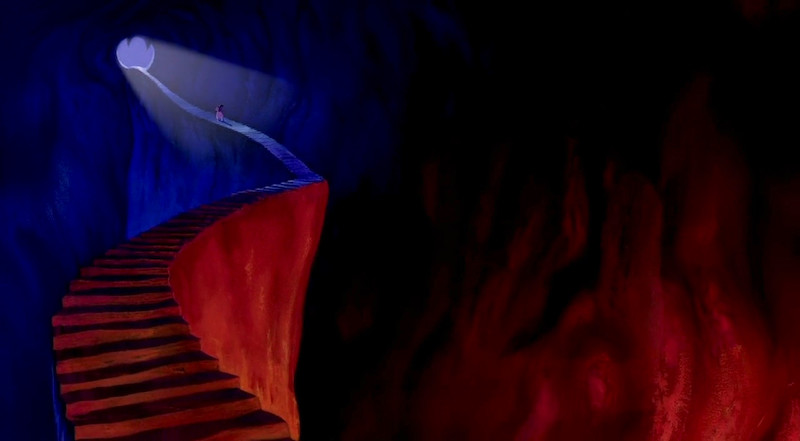
Then another dissolve takes us to the foot of stairs, with Aladdin about to step into the heart of the cave. It's a swift, visually-driven way of taking us down into… Hell? It's hard to say just yet, but it creates a terrific sense of mystery, both promising and foreboding...
0:28:22 – Our introduction to the Magic Carpet is as a simple piece of set decoration underneath Abu as the monkey freezes in mid-air in best cartoon style, in response to Aladdin yelling at him. I've always liked to think that this moment of Aladdin reasserting his moral responsibility not to touch anything is what wakes the Carpet up: it's responding to Aladdin demonstrating his worthiness and responsibility.
0:28:54 – My phone rang, I hit the pause button, this exact frame popped up, and I decided that was a sign that I absolutely had to share it with all of you:
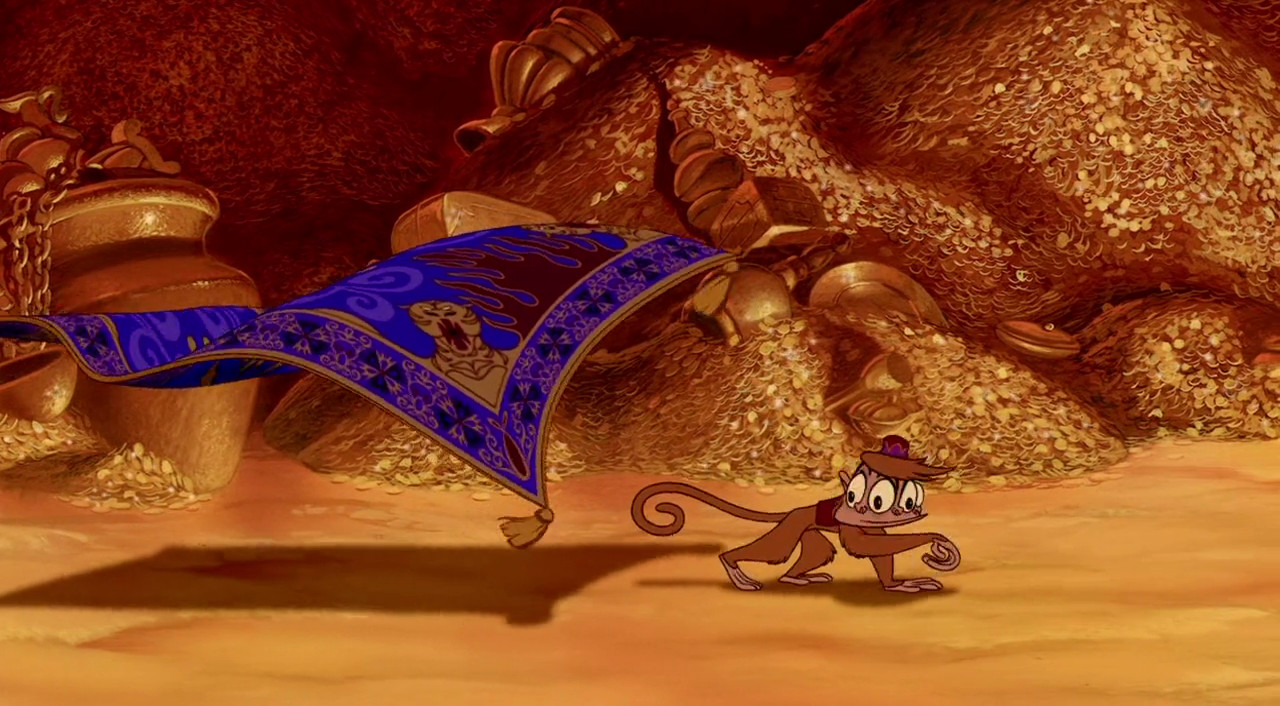
That thing happening with Abu's face? That's one of my absolute favorite techniques in animation. It's called "smearing", and it's when animators create an impression of faster, snappier movement by drawing a single object at multiple places across a motion, in a single frame. Here it is in motion:
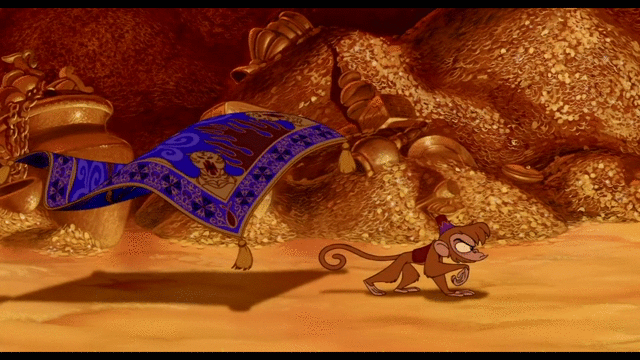
0:30:38 – The use of color as storytelling throughout this movie really is something else. In this sequence, it's all about cool (blue, purple) versus warm (red, yellow) colors.
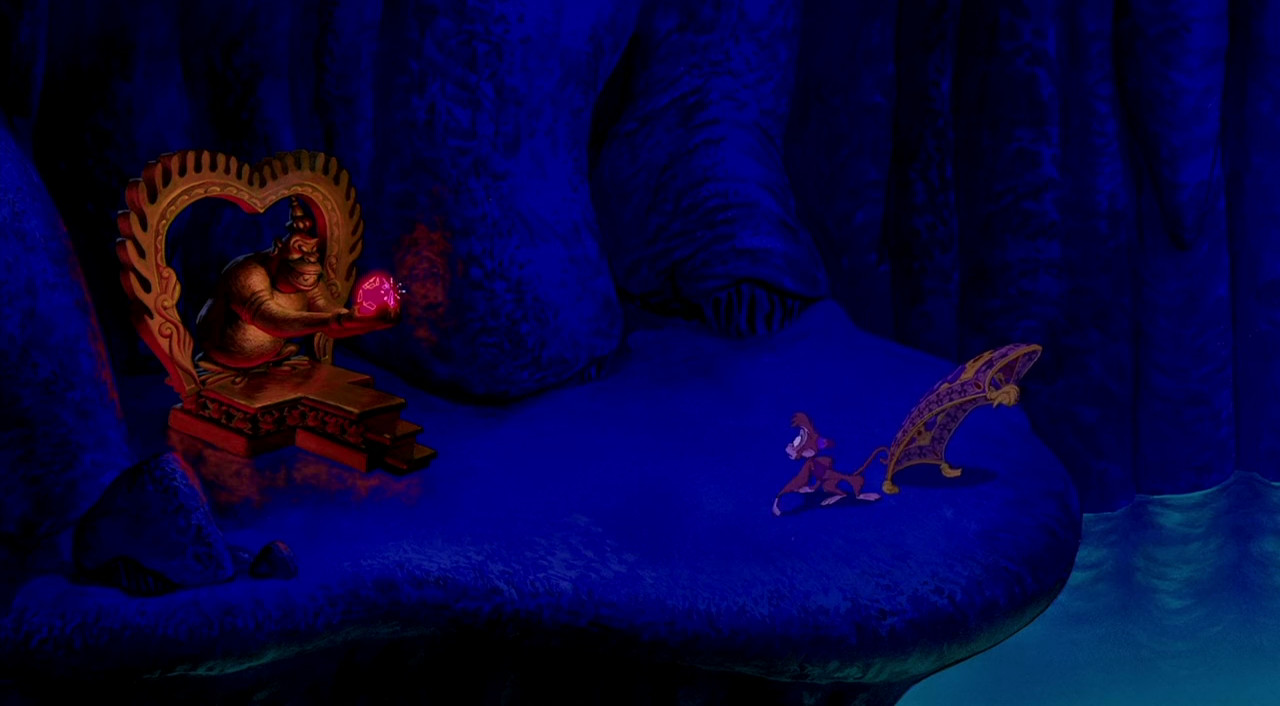
In this case the yellow and red idol that's about to cause so many problems for our heroes popping out violently, almost surrealistically from the cool blue stillness of the cave where Aladdin is about to find the magic lamp.
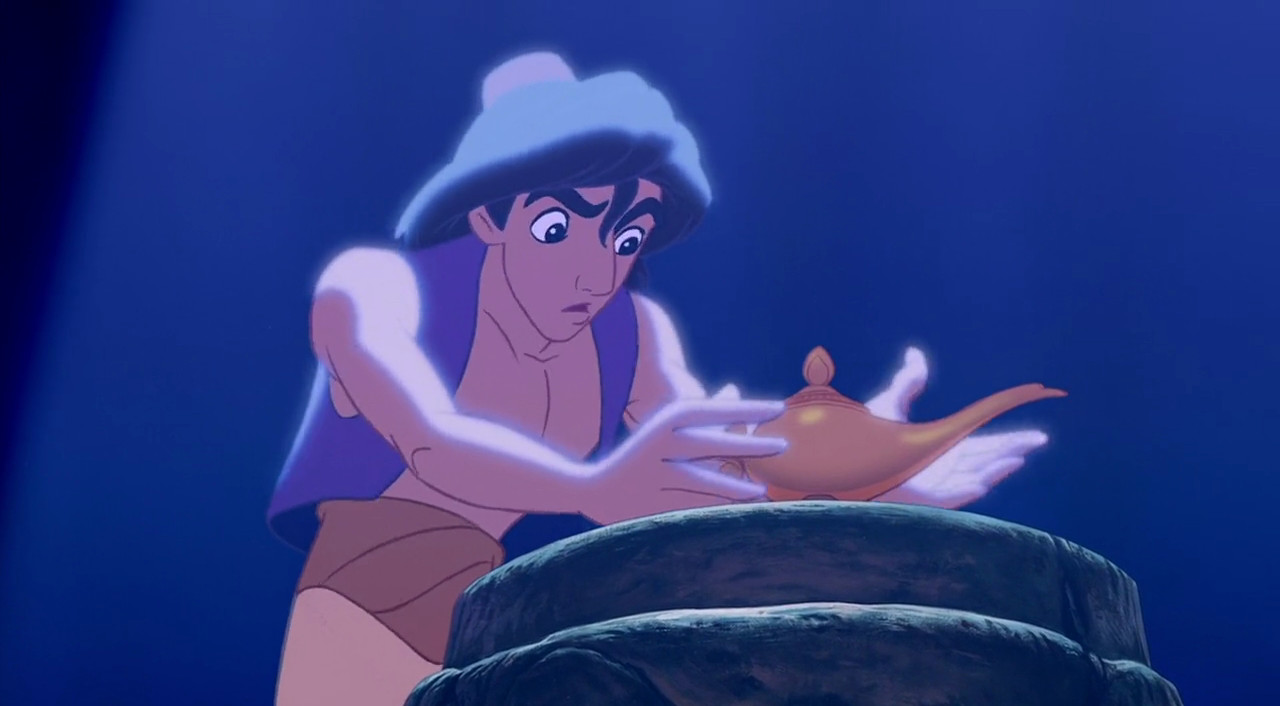
0:31:06 – The narrative linchpin of the whole movie is when Aladdin finds and grabs the lamp. It's playing out concurrently with the carpet trying to prevent Abu from grabbing the forbidden gem, so the moment itself is slightly understated; to make us understand what a momentous event is taking place, the filmmakers rely on minimalism, using an almost empty, monochromatically blue shot as the music drops out from a full orchestra to just a few high-pitched strings for a moment.
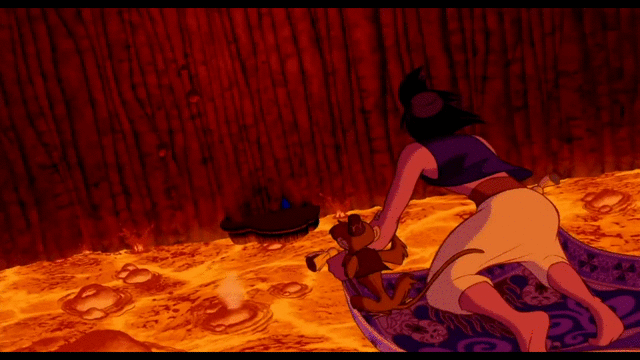
0:32:16 – Every Disney movie around this time had one moment designed to showcase what computers could bring to traditional animation: the ballroom in Beauty and the Beast, the wildebeest stampede in The Lion King. Here, it's the escape from the exploding cave, a first-person flight through a CGI cave that hasn't aged completely well, but still moves so fast, and with such raging music, that it's still exciting almost 27 years on.
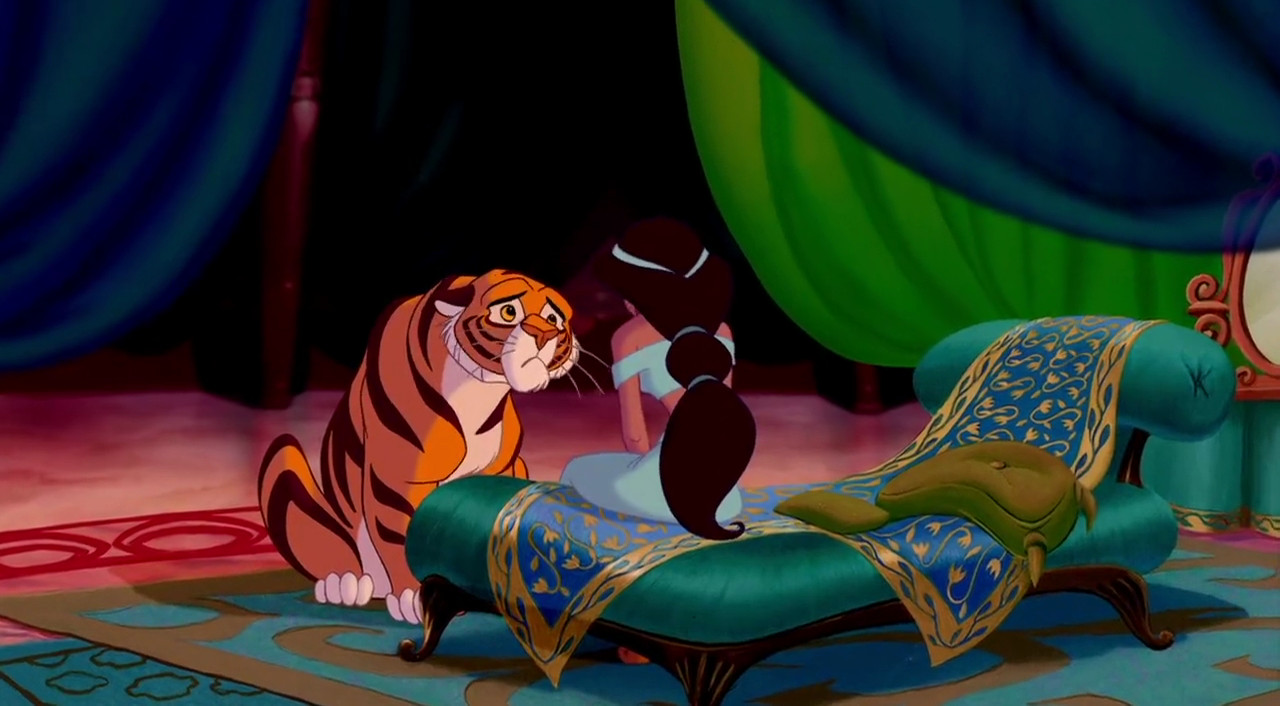
0:34:16 – The brief scene of Jasmine mourning and the Sultan helplessly trying to comfort her has always felt a bit structurally questionable to me (part of the film's bigger problem of never quite knowing what to do with Jasmine as a character), but I am 100% here for the look on Rajah's face.
0:35:30 – At long last, the movie is finally about to actually begin. No disrespect to the rest of the movie, but from the first time I saw this as a 10-year-old right up to the present day, my response to Aladdin has always been that it's a somewhat rudimentary Disney fairy tale about yearning and dreaming and whathaveyou, with neither Aladdin nor Jasmine emerging as nearly enough of a personality to make any of that pop off the screen.
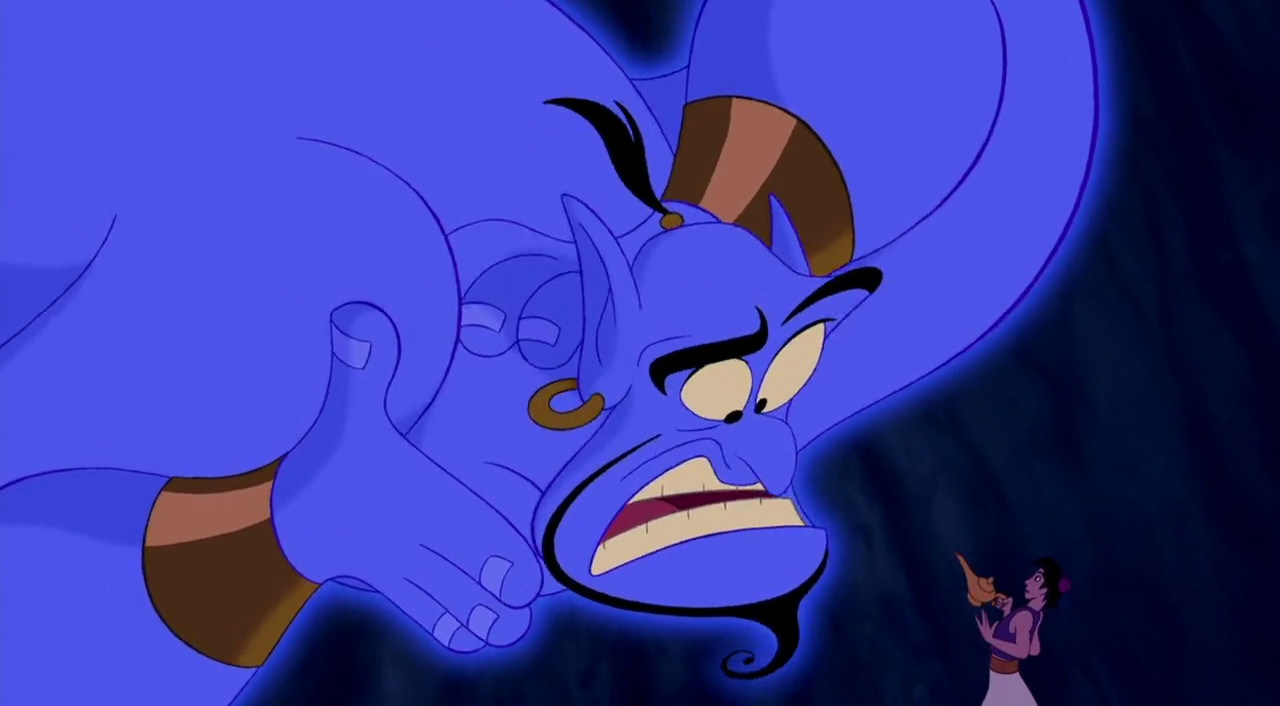
It's only with the arrival of Robin Williams's wildly anachronistic performance as the Genie that Aladdin finally becomes its best self, a rollicking madcap comedy in which one feels like the entire filmmaking team is racing to keep up with Williams's improvisations. It become funnier and more fun to watch in one stroke, and from here on out, the mode is far less that of a genial kids' tale, far more that of an attempt to do Looney Tunes-style cartoon anarchy in the guise of a prestigious Disney musical.
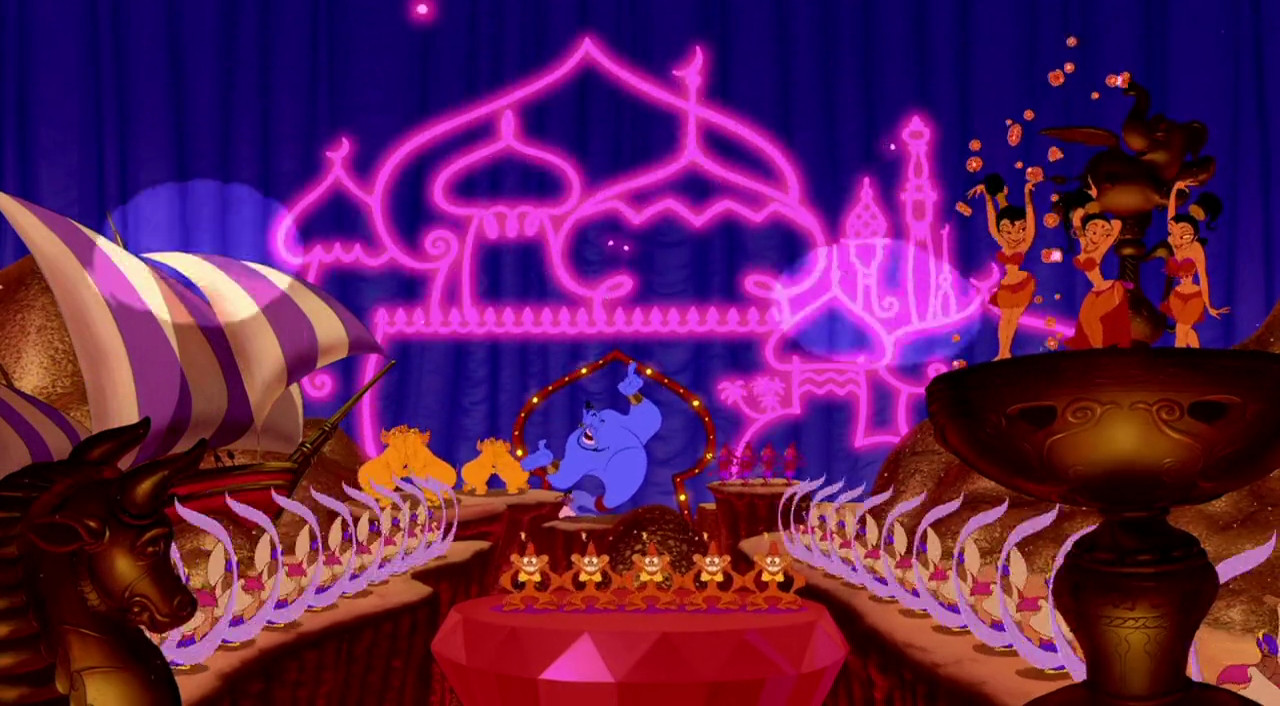
0:37:00 – A great comic character deserves a great comic musical number, and the Genie gets the first of two with "Friend Like Me." In the tradition of "Under the Sea" and "Be Our Guest," the song is mostly an excuse to create a whole bunch of visual gags one after the next, with a blast of uptempo energy to push the film through a song that, in fairness, has absolutely no narrative content whatsoever (its function in the plot is to basically communicate "well, you could ask for this…" over and over again). I'm not trying to slag on it, please understand; the amount of razzle-dazzle Howard Ashman and Alan Menken put into this showstopper is giddy, and you can tell how much fun the animation team had manipulating the Genie throughout.
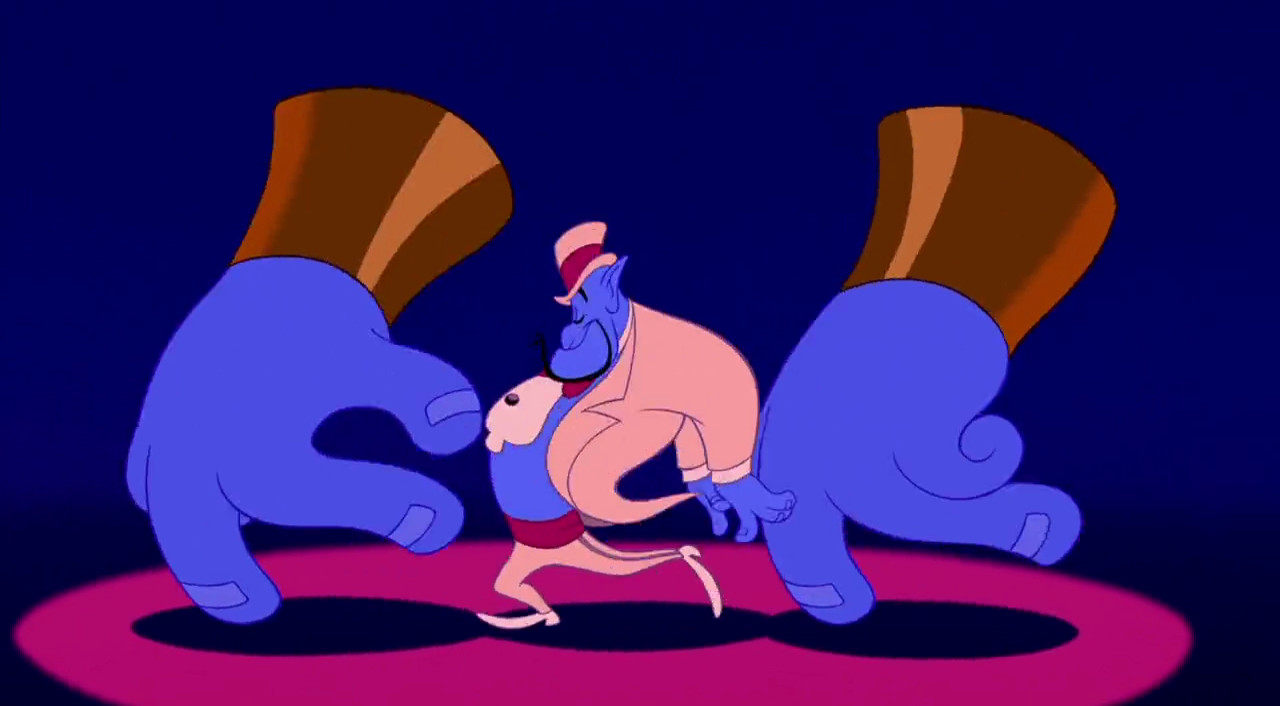
0:38:15 – A nice little tribute to animation history: the Genie dancing with his own hands is a nod to the iconic Mickey Mouse short Thru the Mirror from 1936.
0:40:09 – It would be easy for the film to turn into pure dizzy fantasy at this point, but there's still character work to be done. Once the Genie has laid out the rules, Aladdin and Abu decide to con him out of a wish, getting out of the cave for free. It's played strictly for laughs, but the quiet implication that Aladdin is so invested in trickery and lying that he wouldn't even think of treating the Genie squarely sets up a tension between those characters that will keep coming back into play.
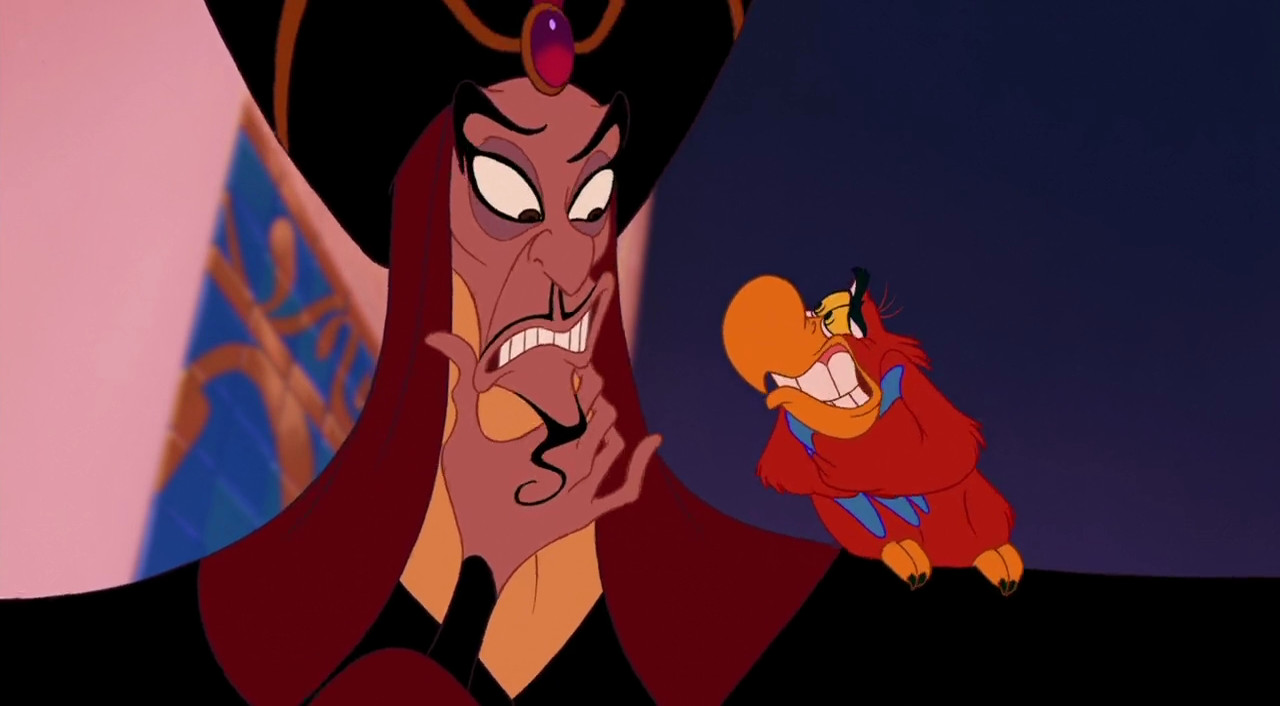
0:40:55 – Another scene back in Agrabah, between the Sultan, Jasmine, and Jafar. This one works as a structural punctuation mark much better than the last; it also gives Jasmine something to actually do, threatening Jafar and thus kicking off the next phase of his villainous plotting. This second part of the scene, which finds Iago coming up with the idea that Jafar should marry Jasmine and acquire the throne that way, is a fun little bit of villainous banter, with some great comic facial expressions.
0:43:44 – At the oasis where Aladdin and company have taken refuge after escaping the cave, we get a bit more comic business before the Genie is given his own "I Want" moment. Creating this kind of pathos for an expressly broad comic character is always a bit tricky, but Williams by this point had enough experience with sentiment to put it over. The casual, instinctive way that Aladdin agrees to free the Genie with his first wish seems friendly and upbeat, but as we'll find out, it's more like thoughtlessness; Aladdin still isn't someone who thinks about what he's going to say or do, and certainly doesn't work out the implications of those things.
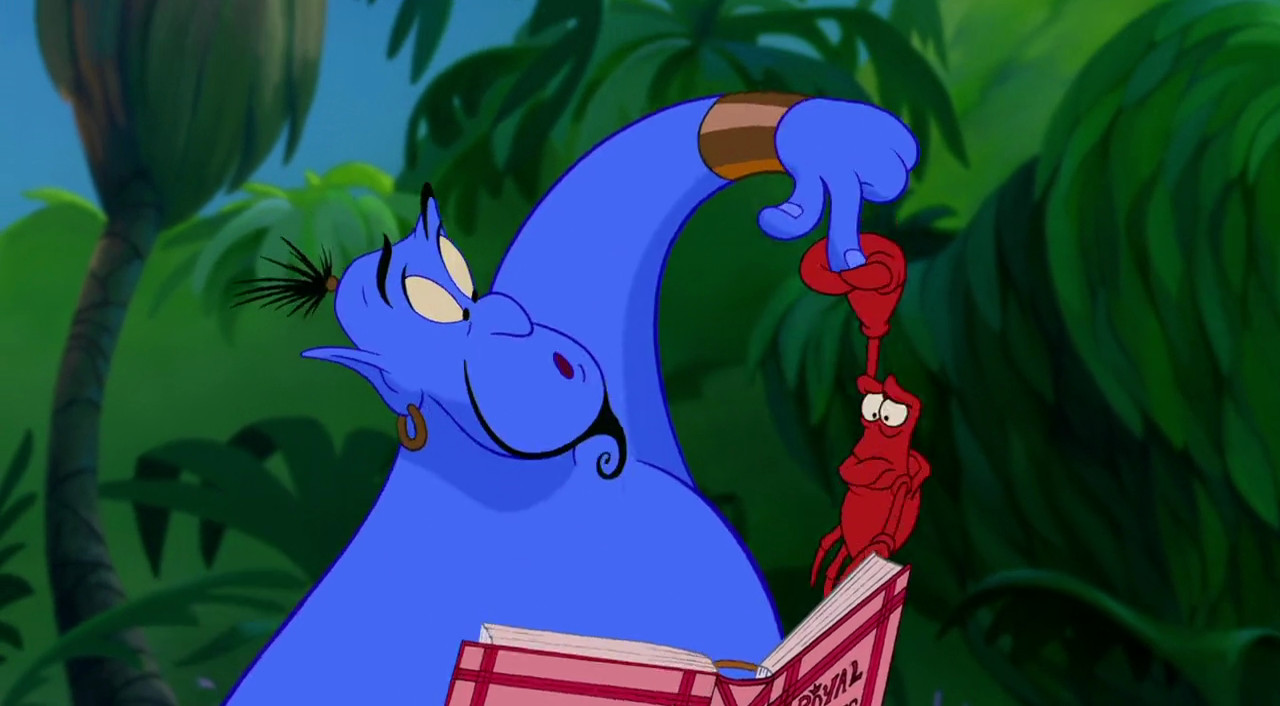
0:45:35 – Cameo alert! When the Genie looks through his magic cookbook to find a way to make Aladdin into a prince, he pulls out a crab, none other than Sebastian from The Little Mermaid, the previous film directed by Aladdin's Ron Clements & John Musker. This is the first in a run of these self-referential gags in Disney movies throughout the '90s; the second one is coming in just a moment.
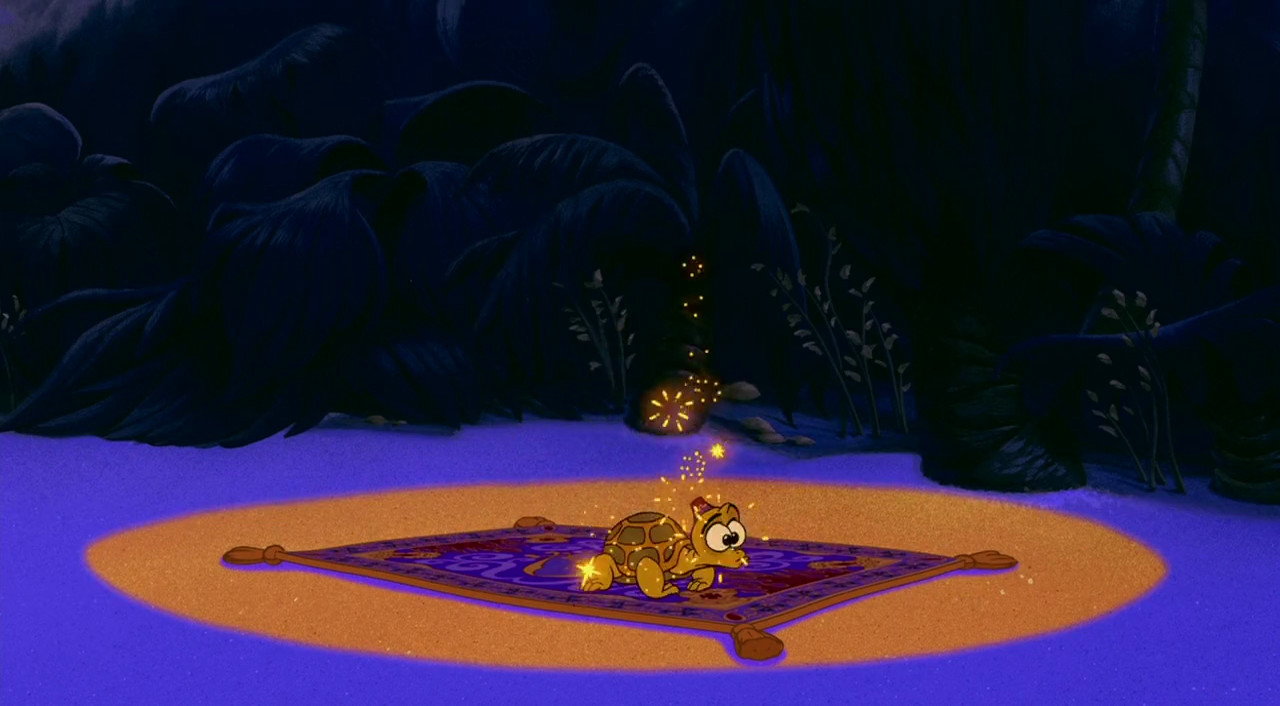
0:46:20 – The gag of the Genie transforming Abu into a wide range of animals is part of a long tradition in animation of distorting a character's body but leaving just enough of their original design that they read as the same character. In this case, it's mostly Abu's eyes and mouth, but his little fez helps as well.
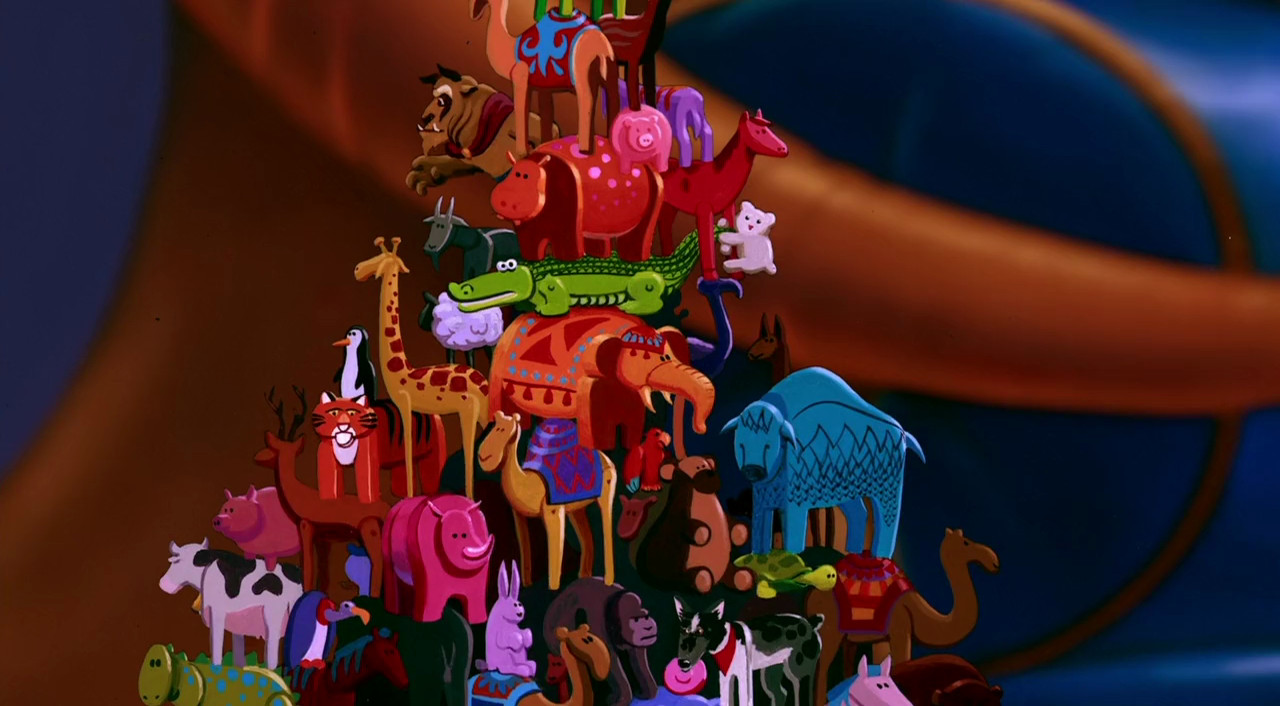
0:46:58 – And here's that second cameo: the Beast from Beauty and the Beast is near the top of the Sultan's tower of animal toys.
0:47:10 – One of the things Aladdin is good at is burying its most mechanical plot moments under comedy and bright colors. In this case, we just need to get to the point that Jafar tells the Sultan about a plot point we've already been introduced to – his plan to marry Jasmine – so to make sure it doesn't drag on too much, the scene is partially structured around the adorably childish Sultan's attempts to cram a cracker into Iago's mouth.
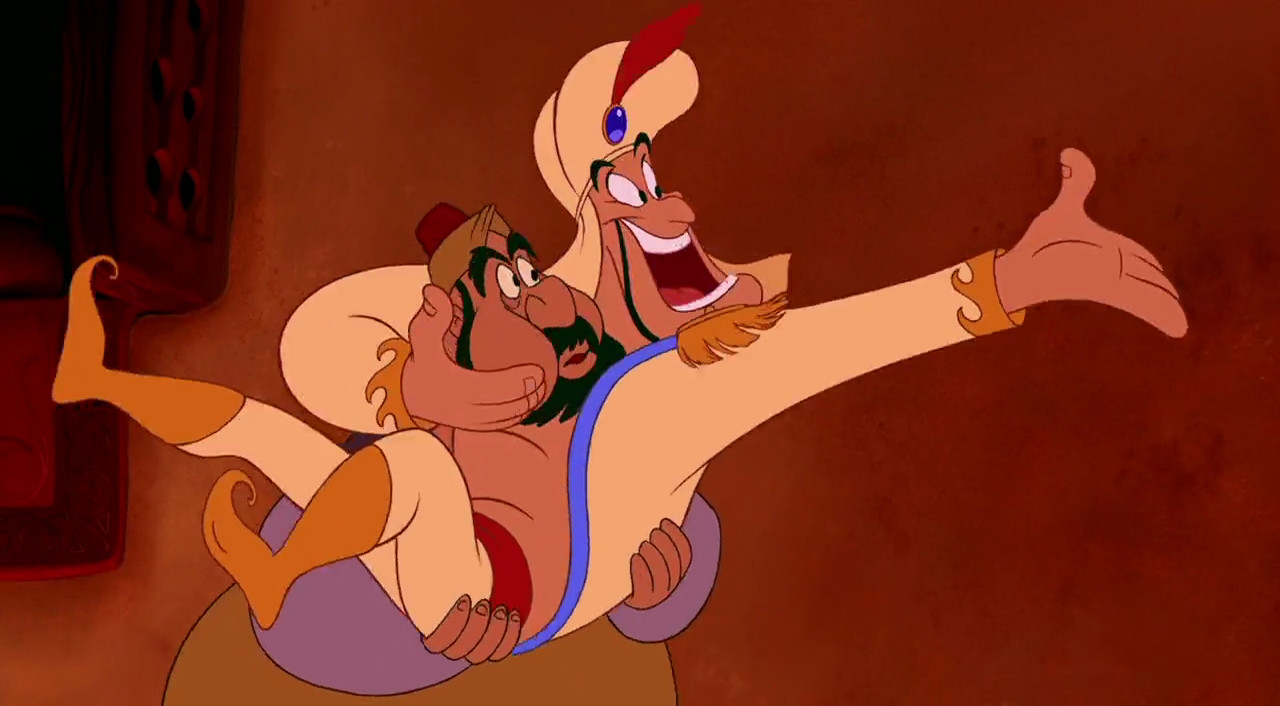
0:48:30 – Perfect timing for another big comedy number, the Genie's second and last showstopper: "Prince Ali." Even though "A Whole New World" gets all of the attention, this is my favorite of the songs in this film, and it's not even really close. It has Howard Ashman's best lyrics in this film, a series of mildly sarcastic rhymes and energetic wordplay (I'm particularly fond of the lines sung by the women gawking at Aladdin from a balcony:
"Everything about the man plain impresses
He's a winner, he's a whiz, a wonder
He's about to pull my heart asunder
And I absolutely love the way he dresses"
Like "Friend Like Me," it's in large part an excuse to show off how having a magic transforming character can result in a wide array of visual gags, but in this case it's also furthering the story. And it's also a fine tribute to the spectacle of a great parade, something Disney in particular knows a lot about.
But I admit, I still get freaked out seeing the Genie in flesh tones.
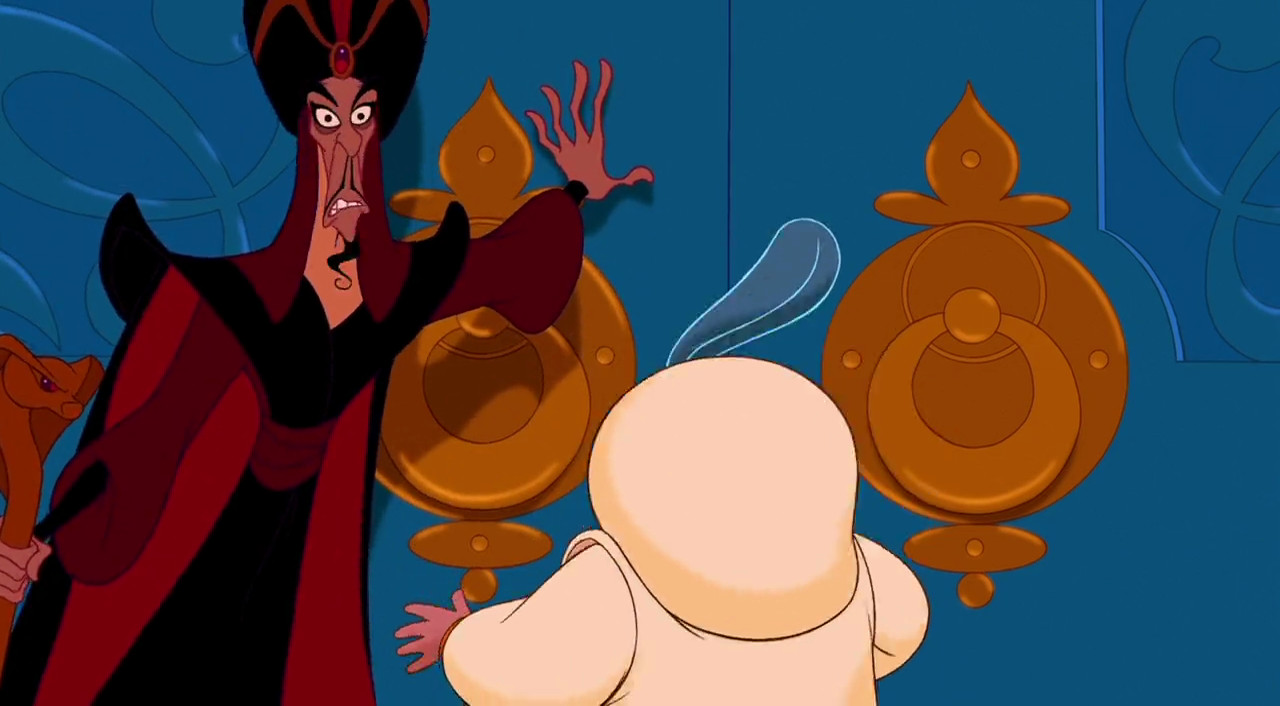
0:50:39 – Jafar's "oh shit" expression a half-second before he gets crushed by an elephant bursting through a door is my favorite frame in this entire movie.
0:51:13 – Another example of the film's careful blend of comedy and plot: the scene after "Prince Ali" is about the conflict between Jafar and Aladdin, and whether or not they'll recognize each other, but the emotional appeal and entertainment is all about the boyish enthusiasm of the Sultan for the magical wonders surrounding him. And all of the jokes start with him. Given that this plot material is entirely functional (we're already several steps ahead of all the characters, and will be for a while), having the distraction is appreciated.
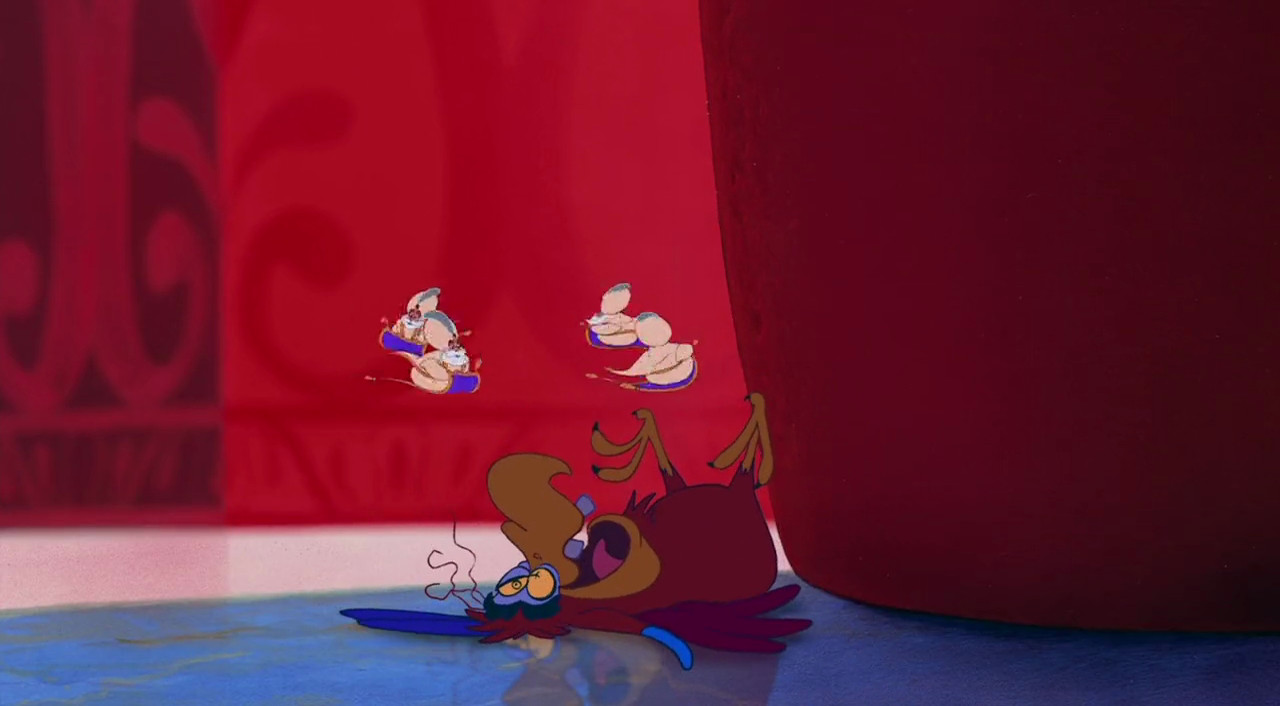
0:52:32 – You've got to love a good inversion: if cartoon humans see birds when they get hit in the head, obviously a cartoon bird would see humans).
0:53:30 – Jasmine's outrage about being treated like a pawn by the men in the palace would hit a bit harder if the film had, to this point, come up with more for her to do that wasn't wholly reactive.
0:55:00 – After a bit of thematizing between the Genie and Aladdin, our two romantic leads begin their courtship in earnest. Of course "courtship" in this case means that Aladdin will try to flim-flam her with a bunch of smooth talk and a fancy, puffed-up accent. She sees through it immediately, and so does her tiger.
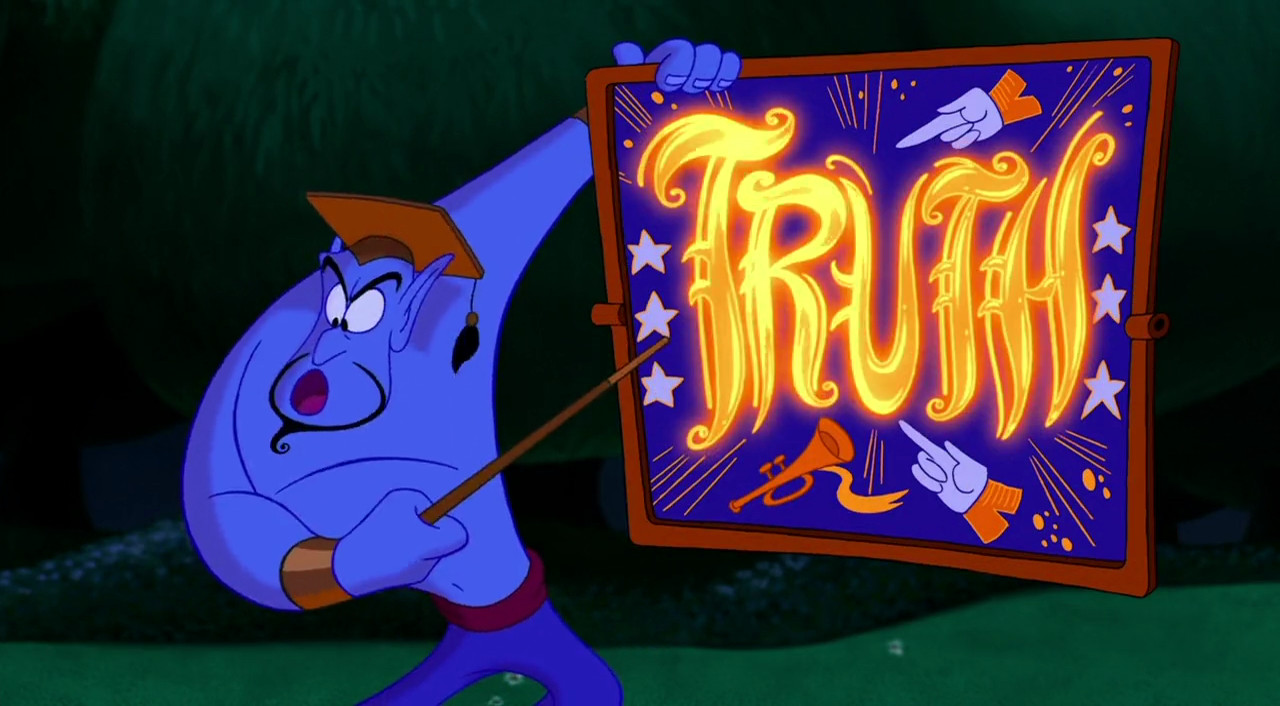
And so we return, after so much comedy and spectacle, to the matter of Aladdin's character arc: if he's going to make anything of himself, it has to be by learning to be thoughtful, honest, and respectful of other people's interior lives. His first inkling that this is true comes in a heartfelt speech he gives right before jumping off a balcony.
The aftermath of that jump is detailed in Part 3 when Nathaniel takes us through the rest of the movie...